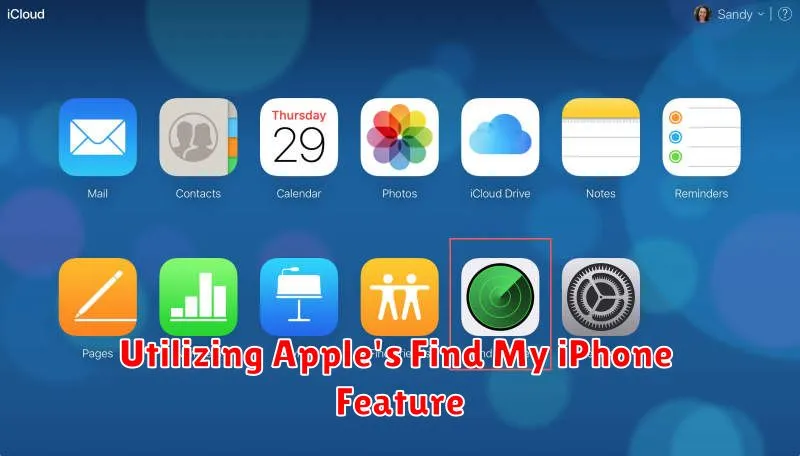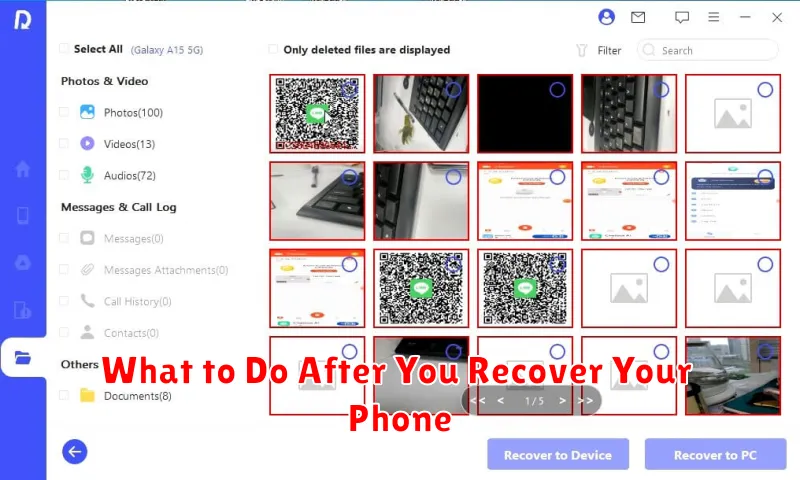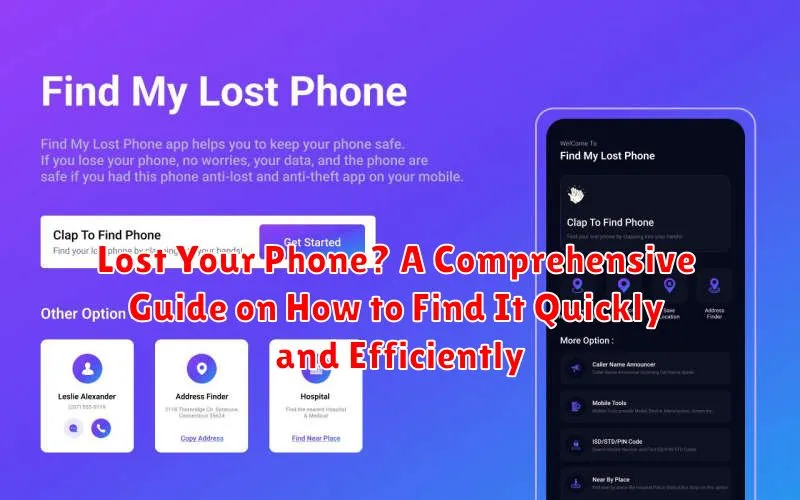Losing your phone can be a deeply unsettling experience. In today’s interconnected world, our smartphones are more than just devices for communication; they are essential tools for managing our lives, storing sensitive information, and connecting with loved ones. The panic that sets in when you realize your phone is missing is understandable, but it’s crucial to act quickly and efficiently. This comprehensive guide provides a step-by-step approach to help you find your lost phone, minimize potential risks, and secure your data.
Whether you’ve misplaced your Android phone or iPhone at home, suspect it was stolen, or simply can’t remember where you last had it, this article offers practical strategies and valuable insights. We’ll explore built-in phone tracking features, third-party apps designed for phone recovery, and proactive measures you can take to protect your device and your personal information. Prepare to learn how to quickly regain control and minimize the stress associated with a lost or stolen phone.
Understanding the Immediate Steps to Take When You Realize Your Phone Is Missing
The moment you realize your phone is missing, it’s crucial to act quickly. Here’s a structured approach to immediately assess the situation:
1. Retrace Your Steps
Before jumping to conclusions, mentally retrace your recent movements. Think about the last place you remember using your phone. Did you leave it on a table at a restaurant? Was it in your pocket when you were walking?
2. Call Your Phone
Have a friend or family member call your phone immediately. Listen carefully for the ringtone. This will help you determine if it’s simply misplaced nearby or truly lost.
3. Check Common Misplacement Spots
Thoroughly search common areas where you might have left your phone, such as:
- Between couch cushions
- Inside bags or purses
- On desks or countertops
- In your car
4. Consider “Silent” or “Do Not Disturb” Mode
If your phone is on silent, use another device to send a message, hoping a notification sound might still be audible, or use Find My Device feature if it is already enabled.
Using Built-In Phone Features to Locate Your Device (Android & iOS)
Both Android and iOS operating systems offer built-in features designed to help users locate their misplaced devices. These tools are typically free to use and relatively straightforward to activate, providing a valuable first line of defense when a phone goes missing.
Android: Google’s Find My Device
Android devices come equipped with Google’s “Find My Device” feature. This tool allows users to remotely locate, lock, or erase their phone’s data. To utilize this feature, ensure that your phone is connected to a Google account, has Location turned on, and Find My Device is enabled in your Google settings.
iOS: Apple’s Find My iPhone
Apple devices utilize the “Find My” app, which encompasses Find My iPhone. Similar to Google’s offering, this feature requires that Location Services are enabled and Find My iPhone is activated in iCloud settings. The Find My network can even locate devices that are offline using Bluetooth technology and other nearby Apple devices.
Leveraging Google’s Find My Device Feature for Android Phones
Google’s Find My Device is an invaluable tool for Android users who have misplaced their phones. This feature, pre-installed on most Android devices, allows you to locate, lock, or erase your phone remotely.
Activating Find My Device
To ensure Find My Device is active, navigate to your phone’s settings, then to Security & Location > Find My Device. Verify that the feature is toggled on. You will also need to ensure location services are enabled.
Locating Your Phone
To locate your phone, visit the Find My Device website (android.com/find) or use the Find My Device app on another Android device. Sign in with the Google account associated with your lost phone. The website or app will display the phone’s approximate location on a map.
Remote Actions
Besides locating your phone, Find My Device offers remote actions. You can make your phone ring at full volume (even if it’s on silent), lock your device with a new password or PIN, or erase all data from the device if you believe it has been stolen and cannot be recovered. Exercise caution when using the erase feature, as it is irreversible.
Utilizing Apple’s Find My iPhone Feature

If you are an iPhone user, Apple’s Find My iPhone feature is an invaluable tool for locating a lost or stolen device. This feature is typically enabled by default, but it’s crucial to confirm its activation to ensure it functions effectively when needed.
To access Find My iPhone, you can use either the Find My app on another Apple device (iPad, Mac, or another iPhone) or log in to the iCloud website.
Once logged in, you will see a map displaying the last known location of your iPhone. From there, you have several options:
- Play Sound: Triggers a loud sound on your iPhone, even if it’s on silent, helping you locate it if it’s nearby.
- Mark as Lost: Remotely locks your iPhone with a passcode and displays a custom message on the screen with your contact information. It also suspends Apple Pay.
- Erase iPhone: Completely erases all content and settings from your iPhone. This option should be used as a last resort if you believe your device has been stolen and cannot be recovered. Note that if you erase the device, you will not be able to track it anymore.
For the Find My iPhone feature to work, ensure that Location Services and Send Last Location are enabled in your iPhone settings under Privacy and the Find My sections, respectively.
Exploring Third-Party Apps Designed to Help You Find a Lost Phone
In addition to the built-in features provided by Android and iOS, several third-party applications offer robust solutions for locating a lost or stolen phone. These apps often provide functionalities beyond basic tracking, such as enhanced location accuracy, remote camera access, and even the ability to trigger a loud alarm to help you find your phone if it’s nearby.
Consider exploring apps like Cerberus (for Android) or similar options available in your app store. When selecting a third-party app, prioritize those with positive user reviews, a strong reputation for security, and features that meet your specific needs. Remember to thoroughly research the app’s privacy policy before installation to ensure your data is protected.
Important Considerations:
- Installation: The app must be installed and configured *before* your phone is lost.
- Permissions: Carefully review and understand the permissions requested by the app.
- Battery Life: Be mindful of the app’s impact on your phone’s battery life.
Remote Locking and Data Wiping: Securing Your Information
Once you have determined that recovering your phone physically is unlikely or impossible, it’s crucial to focus on protecting your personal data. Both Android and iOS provide features for remote locking and, if necessary, data wiping.
Remote Locking: This feature allows you to lock your phone with a new passcode, preventing unauthorized access. This is often the first step to take when you can’t immediately recover your device.
Data Wiping: If you believe your phone has been stolen and your data is at high risk, remotely wiping your device will erase all personal information, restoring it to factory settings. Consider this a last resort, as it’s irreversible.
Steps to Initiate:
- Android: Use Google’s Find My Device platform.
- iOS: Utilize Apple’s Find My iPhone service via iCloud.
By taking these actions, you can minimize the potential for identity theft and protect sensitive information that may be stored on your device.
Contacting Your Mobile Carrier: SIM Card and IMEI Tracking
Upon realizing your phone is lost or stolen, promptly contacting your mobile carrier is a crucial step. They can assist in several ways, primarily by deactivating your SIM card to prevent unauthorized use and incurring further charges.
Your phone’s IMEI (International Mobile Equipment Identity) number is a unique identifier that can be used to block the device from accessing cellular networks, even if the SIM card is replaced. Provide your IMEI number to your carrier; this action can render the phone useless to anyone who finds or steals it.
To locate your IMEI number, check your phone’s original packaging, the purchase receipt, or dial *#06# on another phone. Note that carriers may have specific procedures and requirements for reporting a lost or stolen device, so it’s essential to follow their instructions carefully.
Here’s a summary of actions your carrier can take:
- SIM Card Deactivation: Prevents unauthorized calls, texts, and data usage.
- IMEI Blocking: Renders the phone unusable on cellular networks.
- Account Assistance: Helps manage any potential fraudulent activity.
Filing a Police Report: When and Why It’s Necessary
Filing a police report for a lost or stolen phone may seem like an afterthought, but it’s a crucial step in certain situations. While it might not lead to the immediate recovery of your device, a police report serves several important functions.
When to File a Police Report:
- If you suspect your phone was stolen.
- If you need documentation for insurance claims.
- If your phone contained sensitive information and you fear identity theft.
Why File a Police Report:
- Documentation: A police report provides official documentation of the loss, which is often required by insurance companies for reimbursement.
- Insurance Claims: Most mobile insurance policies require a police report to process a claim for a lost or stolen phone.
- Legal Protection: It can protect you if your phone is used for illegal activities after it’s lost or stolen.
- Assistance in Recovery: While not guaranteed, the police may be able to assist in recovering your phone, especially if it’s tracked and located within their jurisdiction.
Preventive Measures: Steps to Take to Avoid Losing Your Phone in the Future
Losing your phone can be a stressful experience. However, taking preventive measures can significantly reduce the risk of it happening. These steps involve a combination of proactive habits and leveraging technology to safeguard your device.
Implement a Robust Security System
Firstly, ensure that your phone is protected by a strong password, PIN, or biometric authentication. This simple measure can deter unauthorized access if your phone is lost or stolen.
Enable Tracking and Location Services
Activate the “Find My Device” feature (Android) or “Find My iPhone” feature (iOS). Regularly check that location services are enabled. These features are invaluable for locating your phone if it goes missing.
Be Mindful of Your Surroundings
Practice awareness in public spaces. Avoid leaving your phone unattended on tables or in easily accessible locations. Securely store it in a zipped bag or inner pocket.
Consider a Phone Leash or Tracker
Explore using a physical phone leash or a Bluetooth tracker. These devices can alert you if you move too far away from your phone.
Regularly Back Up Your Data
Consistently back up your phone’s data to a cloud service or a computer. This ensures that your information remains safe even if your phone is permanently lost.
What to Do After You Recover Your Phone

Once you have recovered your phone, several crucial steps should be taken to ensure your device and personal information remain secure.
Immediate Security Measures
Firstly, immediately change your passwords for all important accounts (email, social media, banking) that may have been accessed or vulnerable during the phone’s absence. This is especially critical if you suspect your phone was lost due to theft.
Review Recent Activity
Carefully review your recent activity on these accounts for any unauthorized transactions or suspicious logins. Report any anomalies to the respective service providers immediately.
Data Backup and Restoration
If you had remotely wiped your phone, restore your data from your latest backup. Verify that all essential data has been successfully restored.
Re-enable Security Features
Re-enable any security features you may have disabled during the search process, such as biometric authentication (fingerprint, facial recognition) and screen lock.
Update Software and Apps
Ensure that your phone’s operating system and all applications are updated to the latest versions. These updates often include security patches that address potential vulnerabilities.

